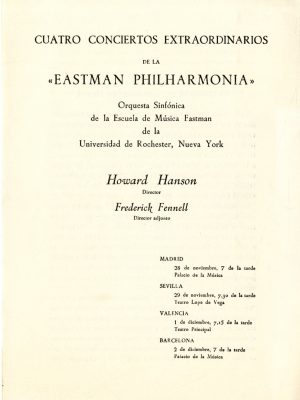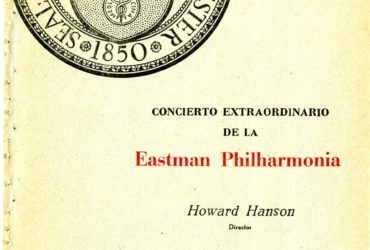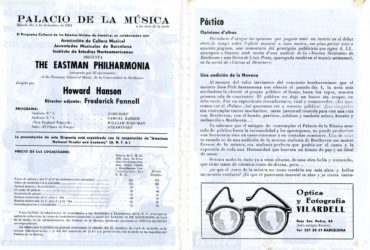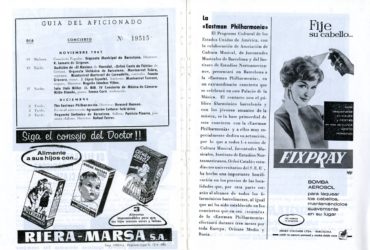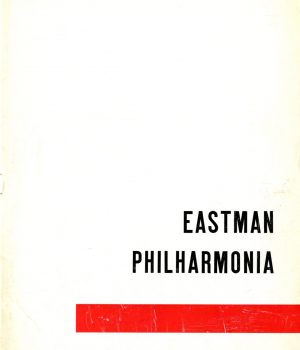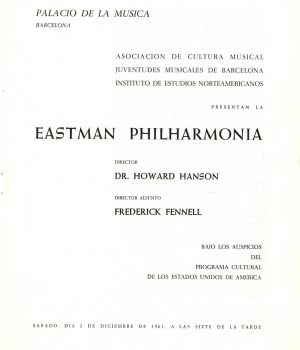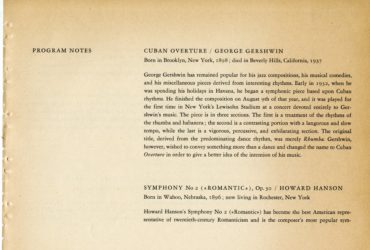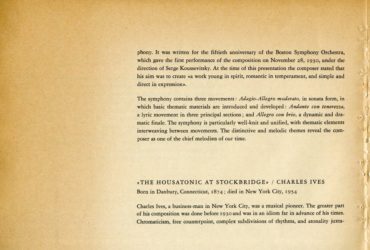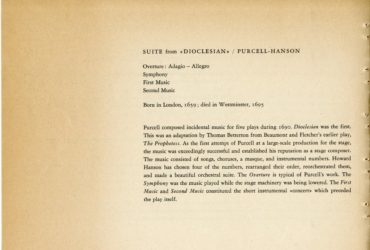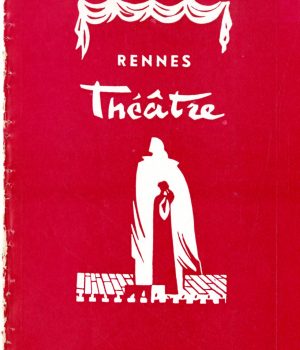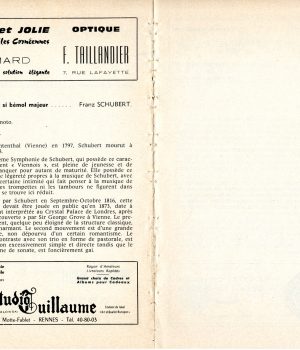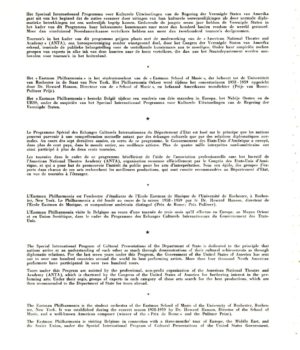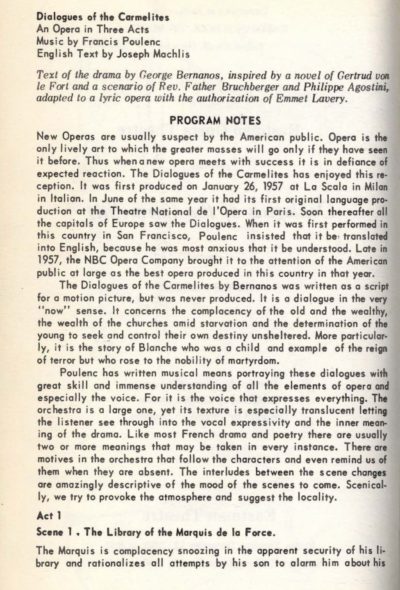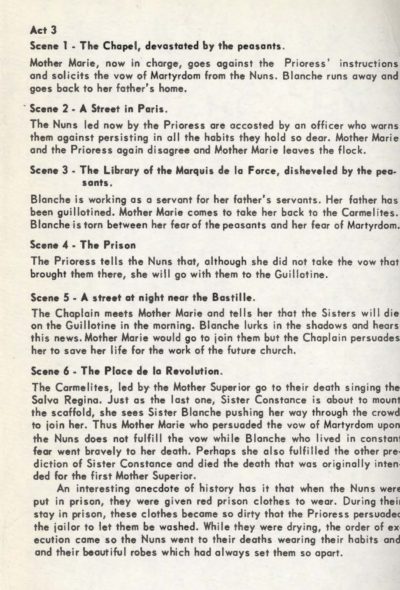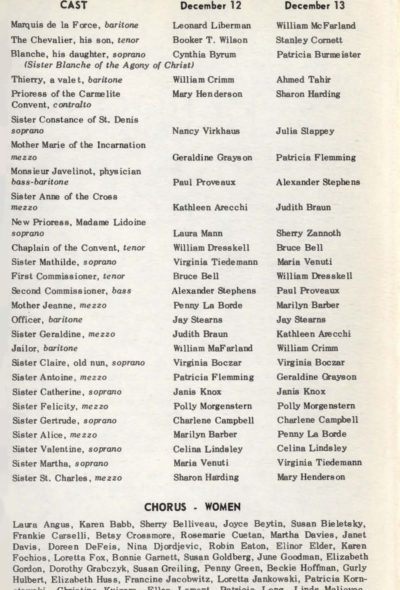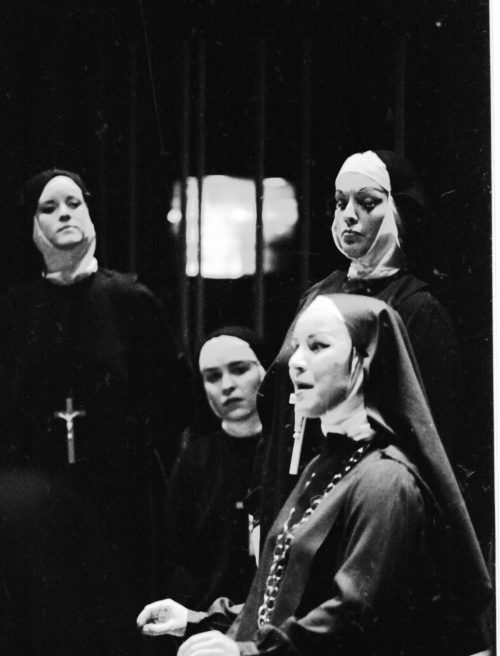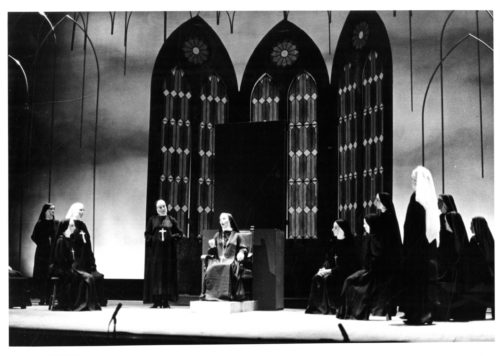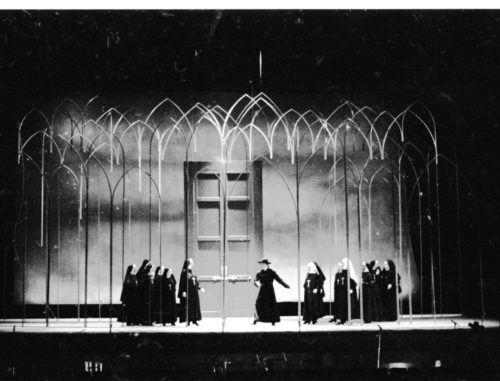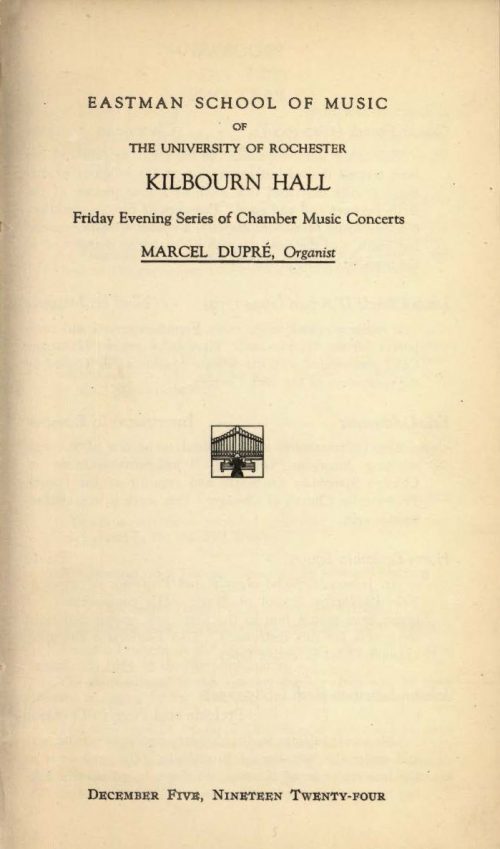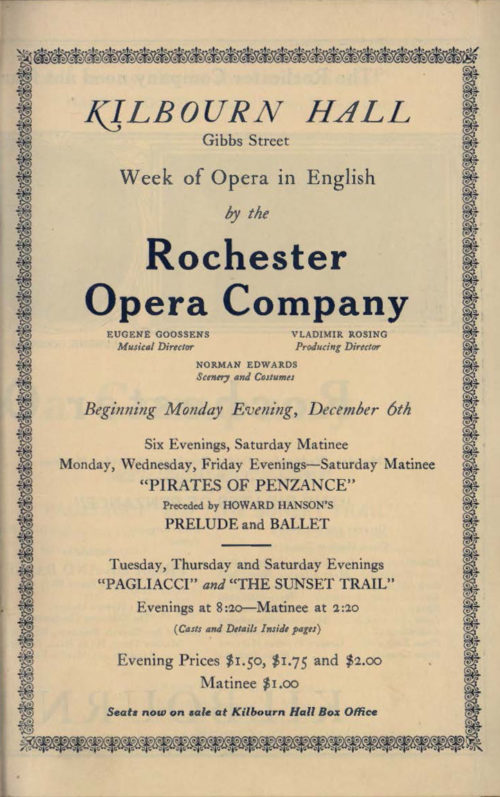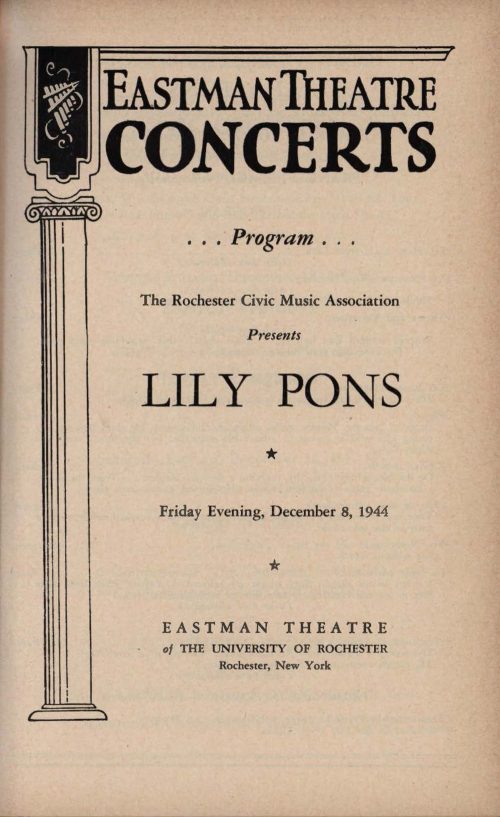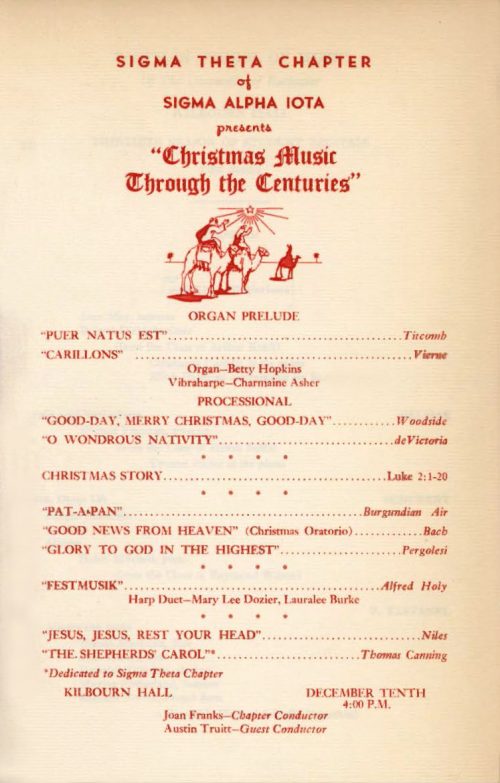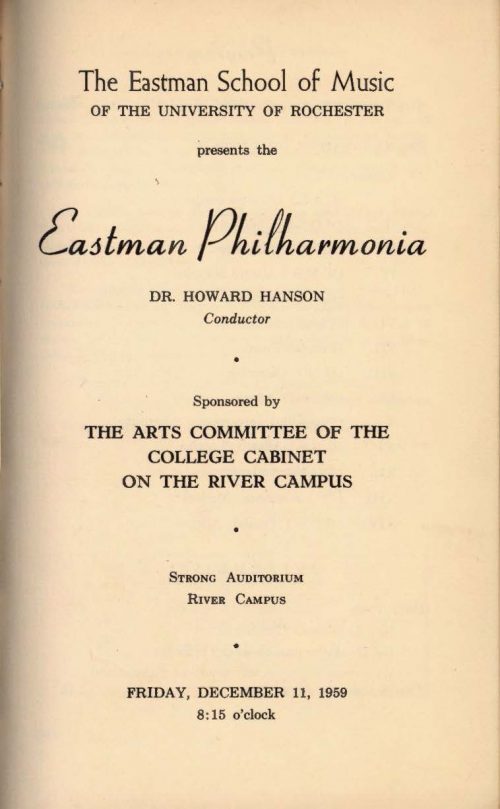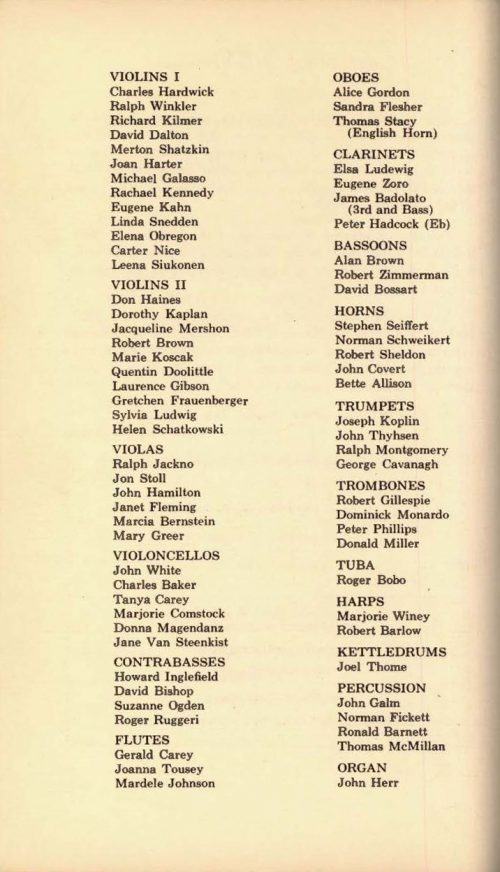Published on Dec 6th, 2021
1961: The Eastman Philharmonia on tour

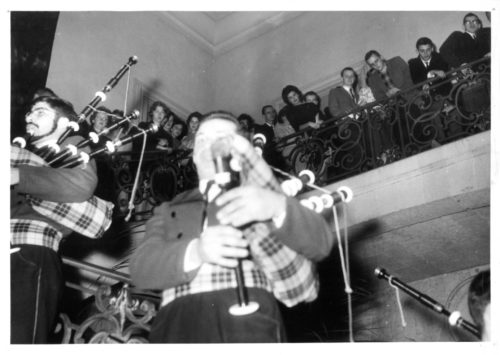
At the concert in Luxembourg, Dr. Hanson and the Eastman Philharmonia members are congratulated by one of the local dignitaries (yet unidentified).
Owing to a recent brush with COVID, last week’s entry in This Week at Eastman did not materialize, and so we will pick up the Eastman Philharmonia story where we left off two weeks ago, which was the orchestra’s arrival on November 25th in Lisbon, where the first concert of the tour was given on November 26th. On November 27th, the Philharmonia members flew by DC-6 to Madrid. Awakening in Madrid on November 28th, the orchestra members had a day for touring and sightseeing followed by a grand reception and then an evening concert at the Palacio de la Música. The Madrid concert was noteworthy in that the auditorium lights began to flicker and then finally went out altogether during the performance of Stravinsky’s Firebird Suite. In spite of the complete darkness, in which the orchestra members could see neither printed music nor their conductor, they remained unflappable and continued their performance by memory and without stopping, a feat which eventually won them a cheering ovation from the appreciative audience.
The next day, November 29th, the Philharmonia members flew to Seville, where there was initially some discussion as to whether their plane would be able to land owing to a state of emergency that prevailed on the ground. Following a huge downpour of rain, the River Tamarguillo, a tributary of the Guadalquivir, had overflowed its banks; in the face of heavy flooding, the city of Seville had been declared a disaster zone. The emergency situation had drawn assistance from the Spanish military and from military personnel of other countries, including the United States Air Force. On the evening of November 29th the orchestra gave a concert in the city’s Teatro Lope de Vega, followed by a gala embassy reception. On November 30th the orchestra members had time to enjoy touring in the city before their flight to Valencia. Awakening in Valencia on December 1st, Philharmonia members had time for more sightseeing before an evening reception and their concert in the Teatro Principal. The following day, December 2nd, the orchestra members flew to Barcelona, where they would spend two full days. On the evening of December 2nd the orchestra gave a concert in the city’s Palacio de la Música. Already in their concerts the orchestra members had been receiving loud acclaim for their encores, and as Philharmonia bassoonist Richard Rodean recorded after the Barcelona concert, “We enjoy the encores as much, if not more than, the program proper.” The encores had been specifically chosen for optimal effect; one work that would remain an obligatory encore from start to finish of the tour was John Philip Sousa’s march The Stars and Stripes Forever.
The Eastman Philharmonia’s 1961-62 tour happens to be one of the most well-documented undertakings in Eastman School history. Quite apart from the official documentation, the printed concert programs, the photographs, and various personal souvenirs that have been archived, the most complete account of the tour is in the hand of one Philharmonia member, bassoonist Richard Rodean, BM ’62, MM ’64, who kept a daily travel log throughout the tour. Besides providing essential details on travel and itinerary — especially important because the official printed itinerary that had been finalized before the tour was changed several times while the tour was in progress — Mr. Rodean’s travel log is suffused with a great deal of local color in observations about cities, concert venues, the details of life on tour and living out of a suitcase, becoming accustomed to local cuisine, experiencing wonder and awe at seeing some of the most famous sites in the world, and the gravity of the realization that the Philharmonia members were representing the United States and the Eastman School of Music in an undertaking of gigantic proportions. As “This Week at Eastman” continues to follow the Eastman Philharmonia, Mr. Rodean’s account of the tour will be a frequent companion.
On December 4th the Philharmonia members flew to Geneva, a 2.5-hour flight, and then travelled by bus up into the Alps to the city of Fribourg, a journey of three hours. The following day, on December 5th, the orchestra gave a concert in the Aula Magna of the University of Fribourg, followed by a gala reception at which the Honorable Robert McKinney, U. S. Ambassador to Switzerland, and his wife were in attendance to greet the orchestra members. On December 6th the orchestra members travelled by road back to Geneva and then by air to St. Nazaire on the French western coast. They they travelled three hours by bus to Rennes, principal city of Brittany and a sister city of Rochester, New York. That evening the orchestra members were feted at a gala banquet, and as Mr. Rodean recorded in his journal, a band of bagpipers was on hand to serenade the orchestra members on their arrival. On December 7th the orchestra members enjoyed a side trip to historic Mont St. Michel, 45 miles away. That evening they performed a concert honoring the civic associations between Rennes and Rochester. The following day, December 8th, the orchestra members flew to Paris, where they would spend two full days without concert engagements, a time when they were free to explore the city. Mr. Rodean recorded in his journal having made an extensive walking tour and a trip to the top of the Tour Eiffel, followed by attending a performance of Berlioz’ Les Troyens at the Paris Opera. “All in all, a day I’m not likely to forget.” One can only imagine that all 87 members of the orchestra thought something similar. The following day, December 9th, the orchestra members were informed that they would spend an additional day in Paris, since their scheduled flight to Luxembourg had been cancelled owing to bad weather at the other end. Mr. Rodean therefore spend the day visiting the Louvre, followed by a visit to the music shop of publisher Durand, where he made a bonanza purchase of scores at a fraction of what they would have cost back home in the States.
On December 10th a concert was on the schedule in Luxembourg’s Palais de la Foire Internationale. The orchestra members flew to Brussels, a last-minute destination change owing to weather conditions, and then travelled by bus to Luxembourg, a ground journey of five hours. They arrived at the concert venue with only twenty-five minutes to spare before concert time, and to make matters worse, the truck carrying their trunks with concert attire had broken down some 35 miles away. As a result, the orchestra members took their seats on-stage dressed in their street clothes, and many with bottles of Coca-Cola beneath their chairs, as they had hastily been served a snack of sandwiches and Coke on their way to the stage. The travails of the day’s travel had exhausted the orchestra members, and the post-concert reception was one that “very few wanted to attend” as Mr. Rodean recorded. The next day the orchestra members visited the American military cemetery where some 5,000 American solders who had perished in the Battle of the Bulge had been laid to rest. After an hour’s flight to Brussels, the orchestra members travelled by bus to Leuven (Louvain) where a concert would be performed that evening. Mr. Rodean wrote that policemen had been posted in the concert hall in response to a student demonstration outside the U.S. Embassy several days earlier in protest of American policy in The Congo, former Belgian colony that had gained independence in 1960, and the scene of much strife.
Mr. Rodean wrote in his journal that on December 12th he had slept until 11:30 AM that morning. It was the case that the tour itinerary had been designed with an eye towards maximizing the orchestra members’ opportunity for sleep following nights of concerts, and also to provide strategically for meals during plane travel. The constant movement by plane and by bus is underscored when one considers that these first two weeks of the tour, when six countries had been visited in the span of two weeks, represented one of the orchestra members’ busiest periods of travel with respect to crossing international borders. In that era before the modern European Union, passport control and currency exchange were the realities when travelling from one European state to another.
Next week we continue the story when the Eastman Philharmonia will finish in Belgium and journey on to Scandinavia
Concert schedule for Spain
Seville, November 29, 1961
Valencia, December 1, 1961
Barcelona, December 2, 1961
Fribourg, December 5, 1961
Rennes, December 7, 1961
Luxembourg, December 10, 1961
Louvain, December 11, 1961
Among the sourvenirs that members of the Philharmonia and their chaperones carried home were all manner of pictorial items. These handsome picture books profiling the covers of, respectively, the cities of Rennes and Leuven (Louvain) were given to Dr. Hanson. .
1969: Dialogues of the Carmelites at Eastman Opera Theater
Fifty-two years ago this week, on December 12th, 1969, Eastman Opera’s first-ever production of Francis Poulenc’s Dialogues of the Carmelites opened in the Eastman Theater. That 1969 production, directed by Professor Leonard Treash (served 1947-1976), was staged when this opera was still relatively new, just thirteen years after its world premiere and seven years after the composer’s death. Significantly, that first Eastman production was staged seven years before the Metropolitan Opera Company first staged this opera, in John Dexter’s 1977 staging. As expressed in the program notes (unsigned, but presumably written by Mr. Treash), “Scenically, we try to provoke the atmosphere and suggest the locality.” The realistic aspect of the Eastman staging and set design extended to an explicit representation of the guillotine in the final scene, the only Eastman production thus far to have done so. The program notes further underscored the popular success that had attended the reception of this opera since its premiere.
Altogether, there have been five Eastman productions of Dialogues (1969, 1980, 1994, 2004, 2014). All but one were staged in the Eastman Theater; the 2004 production was staged off-site at Christ Church while the ET was offline for extensive renovations.
Printed program for the 1969 production. The program notes, unsigned, were presumably written by Professor Leonard Treash.
1975: First-ever PRISM concert presented for NYSSMA
Forty-six years ago this week, on December 6th, 1975, the Eastman School’s first-ever PRISM concert was staged in the Eastman Theater, actually a repeat performance of the concert that had been given one month previously. The PRISM concept was summarized in the printed program as “Sixty-one and one-half minutes of music—non-stop—from every corner of the Theater.” The first performance had taken place on November 7th, a performance specially dedicated to Eastman alumnus Daniel J. Patrylak, BM ’54, MM ’60, a former member of the Eastman faculty and one of the founding members of the Eastman Brass Quintet, who had recently been appointed Chairman of the Department of Music at the University of Texas. The PRISM concert was repeated in the ET on December 6th under the auspices of the annual conference of the New York State School Music Association (NYSSMA).
That very first PRISM concert was described in the pages of Notes from Eastman (forerunner of today’s Eastman Notes) as “an experiment in musical programming”. The success of the experiment was amply borne out in the enthusiastic audience reception, and the PRISM format continued in performance at Eastman across the ensuing several decades.
► Printed program: The December 6th PRISM performance was essentially a repeat of the November 7th performance, with one substitution. Whereas trumpeter Allen Vizzutti, BM ’74, MM ’76 had performed Verne Reynolds’ Etude No. 12 for Trumpet in November, in the December performance he performed Samuel Adler’s Canto I.






